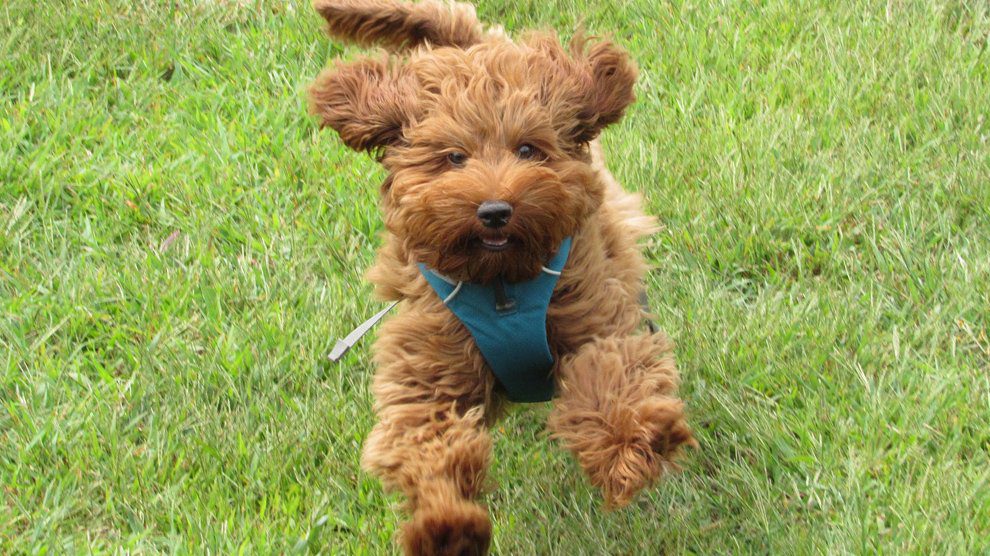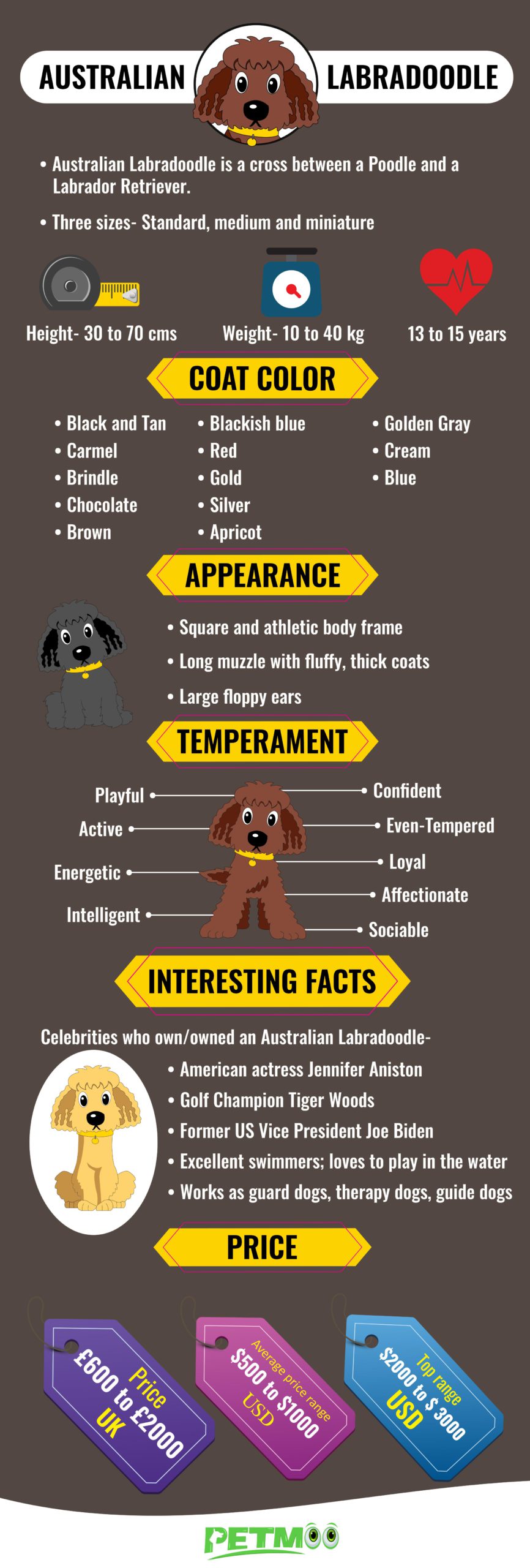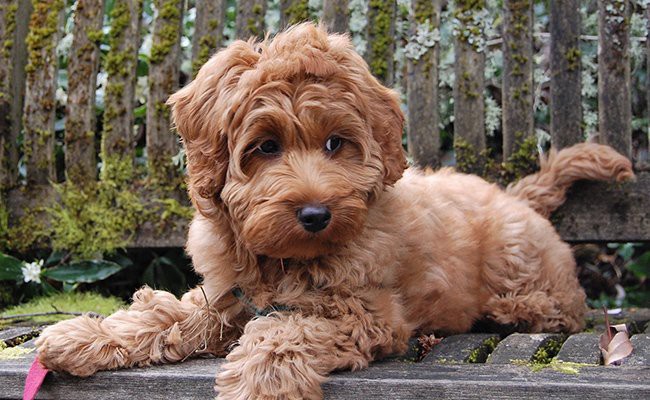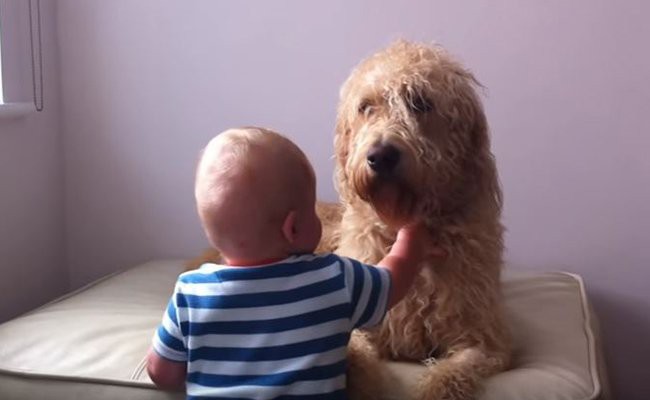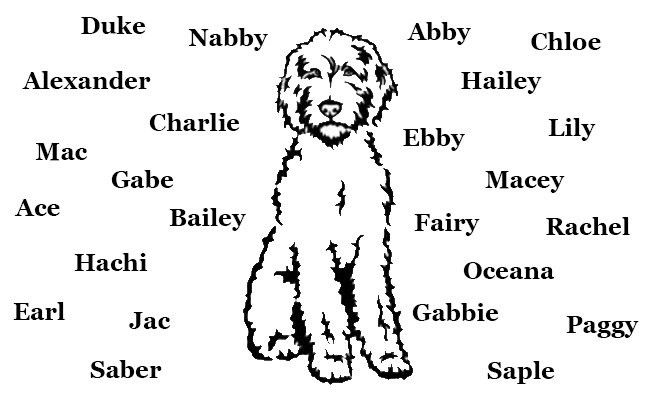Dog Pregnancy Calculator And Timeline
Australian Labradoodle is an enjoyable cross bred designer dog, which is so entertaining and lively.
This breed is mainly for people who want an intelligent and family oriented dog which is also extremely low shedding.
Historical records reveal that the Labradoodle was initially bred in Australia in the 1970s for people with asthma and allergies.
This designer small dog is bred with the combination of following six different parent breeds :
- Labrador Retriever
- Standard Poodle
- English Cocker Spaniel
- Irish Water Spaniel
- American Cocker Spaniel and
- Curly Coated Retriever
Wait… Are Australian Labradoodles different from other Labradoodles?
There are different types of Labradoodles. Some of the differences are not always easy to comprehend. Early-generation Labradoodles suffered from consistency issues. With time, the third and second generation were noted to have undesirable traits.
Labradoodles, in general, are hypoallergenic but some of these crossbreeds still shed a lot. These dogs tend to be normally hyperactive. They require constant exercise and attention.
Australian Labradoodles appear much calmer. They are amazingly smart and easy to train. These dogs normally do not shed and suitable for persons with allergies.
Australian Labradoodle Breed Characteristics Sheet
- Origin: Australia
- Size: Small
- Dog Breed Group: Family dog/Hybrid dog/Designer dog/Service dog/Guide dog
- Purebred: No
- Lifespan: 12-14 years
- Height: Miniature Labradoodle- 14-16 inches ; Medium Labradoodle-18-20 inches(male),17-19 inches(female); Standard Labradoodle-22-24 inches(male), 21-23 inches(female)
- Weight: Miniature Labradoodle- 15-20 lbs, Medium Labradoodle-30-45 lbs, Standard Labradoodle-50-65 lbs
- Coat Appearance: Fleece, wool, hair
- Coat Colors: Phantom, parti, lavender, blue, silver, black, chalk, café’, red, parchment, gold/apricot, cream, chocolate, caramel
- Temperament: Intelligent, social, affectionate, comical, joyful, gentle, friendly
- Good With Children: Yes
- Intelligence Level: High
- Good With Pets: Yes with supervision
- Hypoallergenic: Yes
- Grooming: Moderate (occasional)
- Shedding: Low
- Suitable For Apartments: Moderate
- Need For Exercise: High
- Easy To Train: Yes
- Good For First Time Owners: High
- Health Issues: (PRA) Progressive Retinal Atrophy, Hypothyroidism, Epilepsy, Allergies, Epilepsy, Elbow dysplasia, Hip dysplasia, Ear infections
- Litter Size: 4-15 puppies, average-8
- Average Price: $500 – $1500 USD
Australian Labradoodle Facts
Australian Labradoodle History
In the year 1989, Wally Conron created the first known Labradoodle puppy to meet a visually-challenged woman’s need for a hypoallergenic dog.
Conron decided to mix a Labrador and a Standard Poodle. The allergy-friendly Labradoodle was named Sultan and he worked as a service dog or an assistance dog.
The dog went on to become the woman’s most favorite companion.
After this, Rutland Manor and Tegan Park in Australia started producing Labradoodles.
These breeders were motivated to develop litters with consistent temperament, coat types, and conformation.
Top quality Australian Labradoodles contains a mix of several dog breeds including the Labrador Retriever, Cocker Spaniel, and Poodle.
Multigenerational Australian Labradoodles
- First Cross or “F1” is a hybrid between a Labrador Retriever and a Poodle.
This breeding produces a puppy that has different coats ranging from wolly poodle coats to hairy short coats.
Coats generally vary in texture, thickness, or length. They can range from shedding to non-shedding.
Some breeders avoid breeding F1cross due to variation within the lines. - Back Cross or “F1B” is a designer dog with a Poodle parent and a Multigen. These dogs are corrected because of their Poodle parent.
Coats are varied between shedding to non-shedding. - F2 – Two first generation dogs bred together produces F2 breeds and are suitable for persons with moderate to mild allergies.
- F2B – A F1B bred with a first generation dog leads to an F2B dog and suits moderate allergy persons.
- Multigen or Multigenerational – In this group, both the parents are Labradoodles. According to experts, a multigenerational Labradoodle represents a puppy where both the parents are Australian Labradoodles.
Allergy friendly and no-shedding to low shedding, people love these puppies due to their temperaments, appearance, and coats.
Australian Labradoodle Colors
It appears in various colors:
- Black and Tan
- Brindle
- Blackish blue
- Carmel
- Chocolate
- Red
- Cream
- Brown
- Apricot
- Gold
- Silver
- Blue
- Golden Gray
Appearance
Firstly, they have an attractive appearance that is square and athletic. They are not bulky and at the same time, they look slim too. However, the appearance might differ from dog to dog because Labradoodle is a crossbreed.
These dogs have thick and fluffy coats. They also have a fairly long muzzle. They have long floppy ears in addition to the mischievous eyes, which is covered in soft curls of hair.
Australian Labradoodle Size And Lifespan
Size
There are three sizes of Labradoodle dogs: standard, medium, and miniature. Usually, the height of these dogs is between 30-70 cm.
The weight of Labradoodle dogs is in the range of 10-40 kg.
The various breeds standards include:
Standard – The ideal height for the male and female is 22-24 inches and 21-23 inches respectively.
The weight is between 50-65 lbs.
Medium – In this category, they are between 18-20 inches and 17-19 inches for male and female respectively.
They weigh between 30-45 lbs.
Mini – Not more than 14-16 inches and the weight is between 15-25 lbs.
Australian Labradoodle Lifespan
The life expectancy of this dog breed can be from 13 years to 15 years. However, the statement is applicable only for dogs that are healthy, happy and raised in a good environment.
Australian Labradoodle Temperament
- Affectionate
- Highly Intelligent
- Loyal
- Energetic
- Friendly
- Playful
- Confident
- Sociable
- Even-Tempered
- Active
Difference Between Labradoodles And Australian Labradoodles
| Points Of Difference | Labradoodle | Australian Labradoodle |
|---|---|---|
| Origin | A cross between a Poodle and a Labradoodle | A multi-cross between an American Cocker Spaniel or English Cocker Spaniel, Poodle, and the Labrador Retriever |
| Qualification | Various types depending on the number of generations | They should include the lines of all the above-mentioned dog breeds |
| Types Of Breeding | Labradoodles can belong to a variety of generations – early crosses and all the way up to multigenerational | These dogs are mostly multi-generational |
| Level Of Activity | These dogs need exercise and constant attention | Much Calmer |
| Intelligence Level | Smart | Very sharp |
| Ease Of Training | Being active, not difficult | Super easy to train |
| Shedding | Although hypoallergic, shedding cannot be ruled | Being bred for multi-generations, they are mostly no-shedding dogs |
The standard Labradoodles and Australian Labradoodles are different.
- Standard Labradoodle is a cross breed between a Labrador retriever and a poodle. They are also called Labradoodle Origin, Early Generation Labradoodles, British Labradoodles, and American Labradoodles.
- They are also known as first-generation Labradoodles.
- These crosses are used to create third and second generation dogs.
- All these dogs come only from the lineage of Labrador retrievers and poodles.
- Australian Labradoodles are created by cross-breeding six parent breeds such as- Irish Water Spaniels, Curly Coat Retrievers, American Cocker Spaniels, English Cocker Spaniels, Poodles, Labradoodles.
Australian Labradoodle Grooming And Shedding
It’s not at all difficult to groom your dog if you are in possession of the right kind of tools. For this purpose, you will need a buzz trimmer, blunt cut scissors, and a pin brush.
If you wish to see your dog with flowing hair, brush the coat at least once a week. Ask your groomer not to shave the face or head.
These dogs are considered hypoallergenic-
- They shed minimally, and all the dust, allergens get locked inside their coat instead of flying around in the house.
- Hypoallergic dogs shed less and produce less of allergy triggers such as saliva and dander.
This designer dog can have any of these coat types-
- Fleece coats – A free-flowing coat type
- Hairy coats – The texture can be wavy, straight, or feathered
- Wooly – Slightly softer texture with the tight curls
Australian Labradoodle Food
Generally, these dogs live by consuming raw diet.
The Aussie Labradoodle does not eat much.
Not to mention, the level or frequency of food intake of any dog is based on its age, health, and sensitivity to healthy foods.
Normally, these dogs are fed with a protein-rich diet that is grain free.
Foods They Can Eat:
- Kibble (Superior Quality)
- Cooked Chicken
- Lamb
- Salmon
- Turkey
- Scrambled Eggs
- Boneless duck
- Pumpkin
- Sweet Potatoes
- Peas
- Brown Rice
- Yogurt
- Fruits like apples, oranges and also bananas
Foods They Can Not Eat:
Interesting Facts
- Notably, Labradoodle was initially bred by Wally Conron in Australia.
- Generally, Australian Labradoodle dogs have webbed paws, using which they swim confidently. The Australian Labradoodle dogs are great swimmers.
- Since the Australian Labradoodle puppies are a crossbreed, they are not recognized by any kennel club.
- Moreover, it is a highly versatile dog if properly trained and it is used worldwide as guide dogs, assistance dogs, therapy dogs, and guard dogs.
- Australian Labradoodle dogs like to play in the water. In addition, they wish to run around in the rain and even fond of swimming in lakes and pools.
- Celebrities who own/owned an Australian Labradoodle:
Joe Biden – Former US Vice President
Tiger Woods – Professional Golfer (USA)
Jennifer Aniston – American actress, Film and also a television producer
Australian Labradoodle Names
| Male Dogs | Female Dogs |
|---|---|
| Ace | Abby |
| Alexander | Chloe |
| Bailey | Ebby |
| Charlie | Lily |
| Duke | Fairy |
| Earl | Gabbie |
| Gabe | Hailey |
| Hachi | Macey |
| Jac | Oceana |
| Mac | Paggy |
| Nabby | Rachel |
| Saber | Saple |
Australian Labradoodle Health Problems
1. Food Allergies
Symptoms
- Coughing
- Developing the habit of paw biting
- Head shaking
- Skin rash
- Regularly affected by feet inflammation
- Ears get infected eventually
- Rubbing its face
- Development of licking habit
- Reddish itchy welts on the skin occurring in different shapes on the body
- Gastric problems
- Skin Infections
- Wheezing
Causes
- The source of protein (plant or animal) from a food
- The immune system not allowing entry of such protein
- Certain foods that can cause allergic reactions for the dog include:
- Beef
- Lamb
- Chicken
- Eggs
- Fish
- Dairy Products
- Soy
- Corn
- Wheat
Treatment
- The veterinarian will do health testing and fix the elimination diet for your dog to find out the allergen responsible for creating the food allergy. It will require some considerable amount of time (say like 8-10 weeks).
- Mostly, after halting this diet the vet might recommend corticosteroids for your dog to reduce swelling and also antihistamines to decrease the frequency of itching.
- Antibiotics are also recommended to cure the secondary skin infections
- First, the vet will identify the allergen, and then prescribe stoppage of such food to the dog
- Supplements like probiotics and Omega-3 oils are usually recommended maybe after completion of the elimination diet. Supplements are also given to ensure the normal working of the immune system.
2. Progressive Retinal Atrophy
Symptoms
- Hesitates to travel in the darkness i.e. going outside of the house
- Slow response of the pupils to light
- Greenish shine on the eye
- Night blindness i.e. loss of vision in dim light
- Avoids the daily activities of climbing and running down on the stairs
- Stops the habit of jumping on or off the furniture during the dark
- Bumping on the furniture, wall and also window frames
- Falling over objects
- Delayed response to an alarming situation
Causes
PRA (progressive retinal atrophy) is an inherited i.e. hereditary disease.
Treatment
There is no treatment for curing progressive retinal atrophy in dogs. However, maintaining a similar environment is the only way to just help the dog from not suffering any other problems. Keeping food and water in the same location.
If required, move the furniture to a very limited distance and also place them close to the doors that are situated near the staircases or balcony. You can even put some small gates.
Ultimately, the purpose is to prevent the dog from getting any injuries from falling down.
3. Hip Dysplasia
Symptoms
- Limiting the number of routine activities
- Difficulty in doing activities like standing up, running or climbing stairs
- Disabled hind (rear) leg
- Loose joints
- Unsteady walk
- Closely kept legs while standing
- Uneasiness in the joints, especially while being in a moving position
- Pain
- The overall stiffness of the body
- Noticeably high weight loss in the thigh muscle
- Expansion of the shoulder muscles due to more stress for compensating the lame hind leg
Causes
- Genetic factor
- Poor or malnutrition
- Excess body weight
- Excessive exercise
Treatment
Hip dysplasia treatment in dogs differs from dog to dog depending on the stage of the disease. In mild to moderate cases, medications, dietary and therapy-related recommendations are given.
Dogs that are in the severe stage of the disease will be emphasized to undergo surgical treatment.
- Non-surgical treatment
- Weight reduction exercises to shed extra body weight and reduce the stress on the hips
- Strictly instruct the owner to avoid exercising the dog on a hard surface
- Medications like aspirin, corticosteroids and anti-inflammatory drugs non-steroidal and anti-inflammatory drugs
- Use of joint fluid modifiers, the latest drug that is gradually starting to get utilized
- Surgical treatment
Generally, vets go for surgical treatment based on your dog’s condition or stage of hip dysplasia that it is facing.
Three kinds of surgical methods are followed for treating hip dysplasia
- Double or triple pelvic osteotomy – Dogs which are either 10 months or younger are only operated by this method. The ball and socket joint of the affected dog are made to work properly by the vet, through cutting a part of its pelvic bone and by rotating the segments.
- Femoral head ostectomy – In this surgery, the femoral head of the dog’s hip joint is cut off. This surgery will lead to the creation of a false joint in the dog’s body that can decrease the problems faced by the dog through hip dysplasia.
FHO surgery will not be able to bring the normal hip functioning of the dog but can be a substantial pain management technique. - Total Hip Replacement – This is the most commonly used surgical method where the complete hip joint is replaced with plastic or metal implants. This surgery ensures that the hip becomes normal. It also decreases the pain suffered through hip dysplasia.
4. Addison’s Disease
Symptoms
- Depression
- Anorexia
- Vomiting
- Involuntary shaking of the body
- Insufficient amount of water in the body
- Urinate after very short spells (several times) in a day
- Abdominal pain
- Diarrhea
- Low body temperature
- Weak pulse rate
- Uneven heartbeat rate
- Low blood sugar
- Hair Loss
- Collapse
Causes
- The immune system destroys its own body tissue/s that cause failure of the adrenal glands
- Dog taking medications earlier for Cushing’s disease
- The inability of the pituitary gland to secrete Adrenocorticotropic hormone
- Failure of the hypothalamus in the brain to generate adrenal gland regulating hormones
- Sudden stoppage of steroids
Treatment
ACTH stimulation test will be done on the dog if there are other symptoms for the cause of Addison’s disease. If the dog suffers Addison’s disease, it is controllable through proper monitoring and right medications.
Generally, vets give intravenous fluids to correct the deficiencies and prescribe hormone supplements. Florinef is a commonly prescribed drug for dogs that suffer from Addison’s. This disease is not completely curable.
5. Von Willebrand’s Disease
Symptoms
- Excess bleeding that happens after a minor scratch
- Bleeding that happens for a long time after a surgery
- Pain
- Weakness
- Collapse (might also be fatal i.e. death)
Causes
Genetically transmitted (hereditary) disorder through either of the parents
Treatment
Since Von Willebrand’s is a hereditary disease, there is no cure or some preventive technique. Breeders prior to breeding their dog must test to know if it suffers from Von Willebrand’s.
It is compulsory to do this test because this disease can easily get transmitted to the offspring. Even if the breeder or owner goes for surgical treatment by a vet for blood coagulation in the dog, complete cure is not possible.
Obviously, the reason is that the hormone infusion by the vet for the formation of Von Willebrand’s factor in the blood will only be effective for a short time span.
Australian Labradoodle Price And Breeders
The cost of an Australian Labradoodle dog in the USA can range from $500 to $3000 if bought from a small or average breeder.
As a matter of fact, Labradoodle dogs bought from the top and experienced professional breeders can range from a minimum of $2000 to $3500 or even more.
In the UK market, an Australian Labradoodle can be bought at a price which comes in the range of £600 to £2000. Generally, people who are desirous of owning a dog must definitely be aware of certain factors that determine the selling price of a dog.
Overall, the price determinants could mostly be the age of the dog, its overall health condition, its parents, nature of breeder, and location of purchase (for example, the price may vary from state to state).
Australian Labradoodle Breeders
Australian Labradoodle Adoption
The minimum cost to adopt is around $300 USD to cover the expenditure. Buying from reputed breeders can be a costly affair.
Based on the breeding program, these dogs can cost between $500-$2500 USD.
Most of the breeders can charge a separate fee for transportation.
The easiest method would be contacting a rescue that also specializes in these dogs. Labradoodle Shelters and rescues offer many options.
Breeders Of Australian Labradoodle USA
- Manor Lake Australian Labradoodles
Address: 2950 Newmarket Street, Suite 101-181
Bellingham, WA 98226
Tel.: (360) 303-0497
E-mail Id: kim@manorlakelabradoodles.com - Labradoodles of Long Island
Address: 46 Buccaneer Ln, Setauket- East
Setauket, NY 11733, USA
Tel.: +1 631-941- - Adam’s Australian Labradoodles
Address: 4554 San Blas Ave,
Woodland Hills, CA 91364
Tel.: (818) 694-8206
E-mail Id: LAdoodles@gmail.com
Breeders Of Australian Labradoodle UK
- Tora’s Australian Labradoodles
Address: Barrs Rd
Cardross, Dumbarton G82,
Tel.: +44 1389 841027 - Hampshire Labradoodles
Address: Clanfield, Waterlooville
Tel.: +44 23 9235 2665

